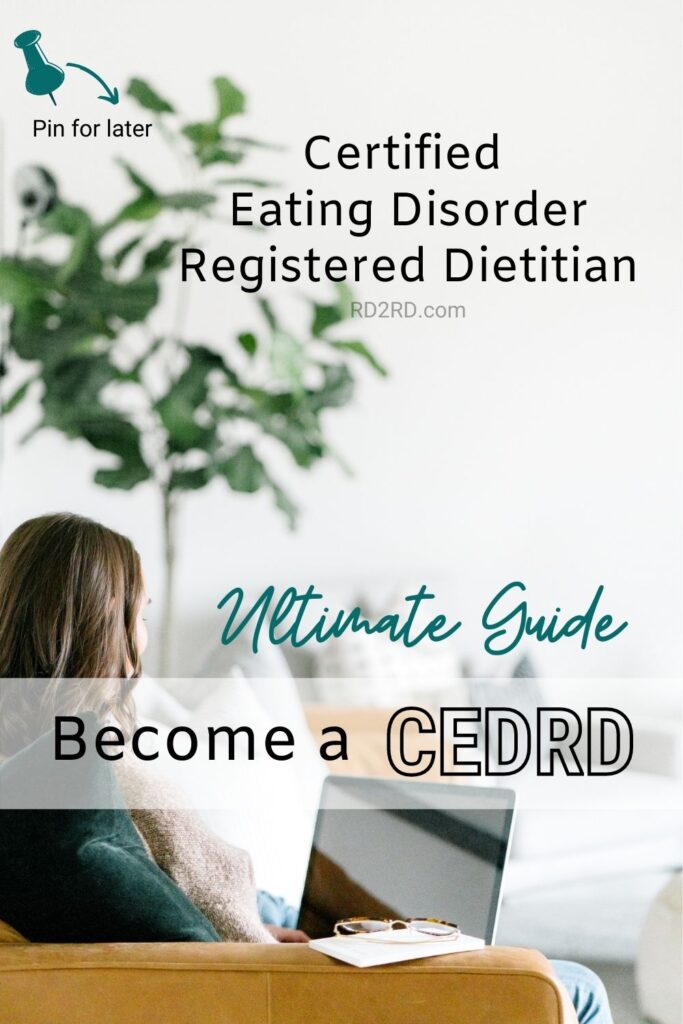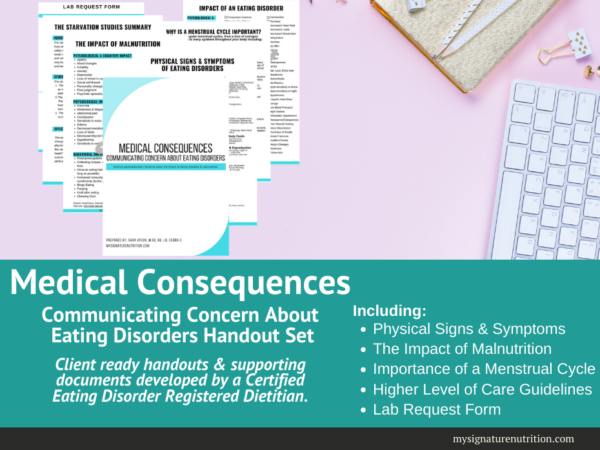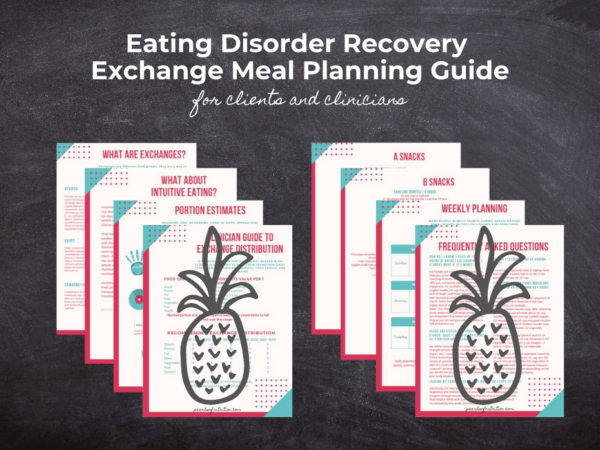Have you heard of the CEDRD credential? The CEDRD certification is the credential for a Certified eating disorder specialist, specifically a certified eating disorder dietitian.
Managed by The International Association of Eating Disorders Professionals, IAEDP for short, the CEDRD certification is for registered dietitians and registered dietitian nutritionists.
The IAEDP also has credentials for other professionals who are working in treatment with people with disordered eating. More about that in a bit!

What is the difference between an RD and a CEDRD?
A registered dietitian is a nutrition professional that has completed (at a minimum)
- a bachelor’s degree in nutrition from an accredited university
- completed a 9-10 month supervised practice experience
- passed the national board exam.
In addition, RDs have to maintain licensure and continuing education hours as guided by their state.
A certified eating disorder registered dietitian (CEDRD) is a dietitian with extensive additional experience and training in the realm of disordered eating, and has completed all formal requirements by the IAEDP to obtain and maintain the CEDRD certification.

What is the difference between the CEDRD and CEDS certifications?
Effective treatment for patients with disordered eating is best offered in a multidisciplinary approach. As such, the IAEDP offers certificates of training programs to a few different professional backgrounds, including nurses and therapists, in addition to registered dietitians. The right certification for you is based on what your professional background is.
One of those is the Certified Eating Disorders Specialist (CEDS). The CEDS is for physicians, physician assistants, nurse practitioners, psychologists and Doctors of Osteopathic Medicine, as opposed to the CEDRD, which is for registered dietitians (1).
Benefits of becoming a CEDRD
The CEDRD certification training is complex, comprehensive and provides a solid framework for certified eating disorder registered dietitians to provide evidence-based care. It may increase opportunities to apply for jobs, obtain promotions and get raises as well as boost credibility in a private practice setting.
One unique benefit of the CEDRD certification is that it counts for all 75 hours of CEUs required by the Commission on Dietetic Registration (CDR) for the five-year certification cycle.
Working in the field of disordered eating is highly specialized. One other powerful benefit of becoming a CEDRD is required supervision hours. As you are managing complex cases, you’ll have the support to feel confident and to be effective.
Having the right training helps you to best understand your patients, where they’re coming from and how to most effectively help them.
Considerations before becoming a CEDRD
Becoming a CEDRD does require a significant investment of time and resources. And to keep the credential, continuing education must be completed every certification period, which is two years long. Not only is there the cost to take the exam, there is also the cost of hiring your supervisor for the required hours. Supervisors may charge $100-150 per hour and you must document twenty-one hours in order to become a CEDRD.
To others, this feels like the structure and accountability that they feel best suits their professional goals and needs.
Another consideration is insurance reimbursement. Some insurance providers are prioritizing reimbursement to providers with this credential, but the details of this vary by state and by the specific insurance company.
Some dietitians with the certified eating disorder dietitian credential feel that having the CEDRD credential is a benefit in terms of marketing and establishing your practice niche. The credential may distinguish you from other local practicing dietitians and may help to connect you with referral partners. The CEDRD designation offers professional identity and is one way to demonstrate commitment.

How to become a CEDRD
Are you ready to go for it? In order to apply to become a CEDRD, you must first meet the following robust eligibility requirements:
- Be registered with the Commission on Dietetic Registration (CDR)
- Be a member of the IAEDP
- Demonstrate core course expertise
- Have accrued a minimum of 2,500 eating disorder-specific practice hours under the guidance of an iaedp™-Approved Supervisor(s) [Note: you cannot start accruing hours until you’re licensed, i.e., hours during your internship in this field will not count]
- 21 hours of supervision (5 of which can be in a group setting)
You can find the application to apply here. Your application will include:
- A detailed history of your professional work experience
- A case study
- Three reference letters
- The $150 application fee
- A headshot
Required Supervision for CEDRD
In order to apply to become a CEDRD, you must accrue and document 2500 hours of work in the field. These hours are supervised and signed off by your CEDRD supervisor, abbreviated CEDRD-S. A few things to note about these hours:
- 75% of the hours must be in direct patient care
- 25 of the hours can be indirect care, including charing and documenting
- Hours must be accumulated over a minimum of two years
- 1 hour per 120 patient care must be directly supervised by your CEDRD-S. Note: CEDRD-S typically charge an hourly fee for this time.
For more details about hours and how they’re accrued please click here.
Note: finding the right CEDRD-S for you and your professional goals should be a top priority. You do not have to choose the closest or most convenient supervisor. Remember that you would not want a client to choose the first therapist/RD/physician/nurse that they met if they were not comfortable; so, give yourself and your supervisory experience the same respect.
Case Study
One aspect of competency demonstration involves the preparation of a written case study of an eating disorder patient with whom the registered dietitian has completed treatment. You can find more information about this requirement here.
CEDRD Exam Prep
To prepare for the exam, the IAEDP offers an exam prep course. Once you’re ready to take the exam, you must register and pay the $100 fee. The exam is online, proctored and takes a maximum time of three hours to complete. The minimum passing score is 80%.
Once you pass the board examination, your CEDRD certification is valid for two years. At the end of which time, you must renew.
Note: in the past, a different route to CEDRD certification existed, called the equivalency route. The purpose of this route was to provide accessibility to the certification to those leaders in the field who did not need supervision. This path to certification ended in December 2020. All new applicants must follow the traditional route, outlined above.
To renew your CEDRD certification, you must meet the following requirements:
- Satisfactory completion of a total of 20 hours of continuing education specific to eating disorders
- Maintain membership in the IAEDP
- Pay the renewal fee (currently $150)
- Maintain professional licensure
- Continuing education hours
- Attend at least one IAEDP symposium every four years (or every two renewal periods)
Note: supervised hours are only required for the initial requirement, not for recertification. However, some dietitians will choose to continue with supervised hours.
Here is the application to renew your CEDRD certification.

Working in the Field
Working as a CEDRD can affect meaningful change anywhere that there are people with disordered eating. That is to say: everywhere.
Perhaps the most traditional venue is in a treatment clinic specifically focused on disordered eating. This could be in-patient or outpatient. One potential perk of working in a larger practice or treatment center is that you could be able to connect with your CEDRD-S where you work. If this is the case for you, and the two of you are a good fit to work together, this will defray the cost of hiring a supervisor elsewhere.
And if you’d like to see what kind of job opportunities exist today, the IAEDP has a job board available for you to pursue the most recent postings.
But that is just the beginning: your private practice should focus on this meaningful niche.

Or, you could contract with sports teams and dance teams to provide guidance to their elite athletes, promoting constructive eating patterns that support both their training and mental health. Use the following support and educate your clients while saving you time.
- Sports & Eating Disorders Presentation
- Food and Movement Rules: Exploration Worksheet
- What I Ate vs. What My Body Needs
- Athletes Recovering from Eating Disorders
- Assessing your Relationship with Exercise
- Intuitive Eating for Fitness Workbook
Working on a college campus would be a meaningful opportunity, too. Work here can include prevention of disordered eating, intuitive eating as well as treatment, both in group settings and individually.
You can also weave messages beyond calorie counting if you provide grocery store tours!
While disordered eating is quite serious, not every lesson or intervention has to be serious. Games can be a fun and effective way to teach your audience about a more constructive relationship with food and eating.
For more information about the latest research about disordered eating, you can read Eating Disorder Review, for clinical information curated by the IAEDP. You might also consider becoming a member of the IAEDP and joining the #INSPIRDtoSEEK Facebook group.
WellResourced is your go-to for tools and education handouts
We have many tools and worksheets to empower your clients to explore their patterns and assumptions with curiosity instead of judgment. These include high-quality tools made by CEDRDs.
Spend more time with your clients instead of reinventing the wheel by downloading the worksheets that support your business.
Key takeaways about becoming a CEDRD
Becoming a CEDRD is an extensive journey that empowers registered dietitians to be experts in the field of disordered eating. By meeting the extensive training and educational requirements, networking and practicing with your CEDRD supervisor, you’ll feel confident, even with complicated cases.
Whether you’re getting started in the realm of supporting clients with disordered eating or looking to further hone your skills and knowledge, we have tools to support you and your practice.















3 comments
I am in my internship right now and have been thing ED is the area for me. LOVED reading this! Shows pros and cons and the steps!